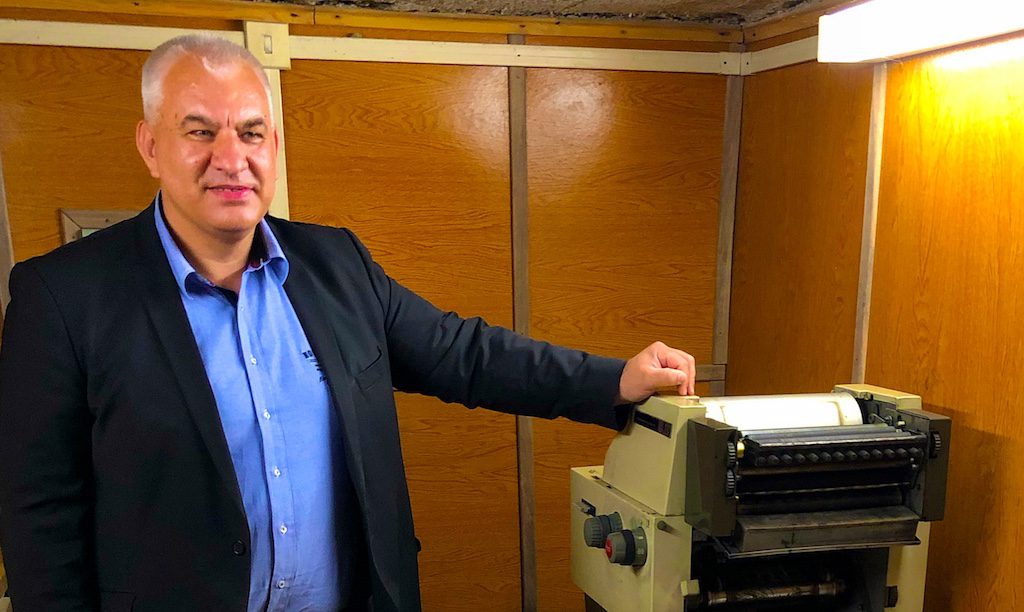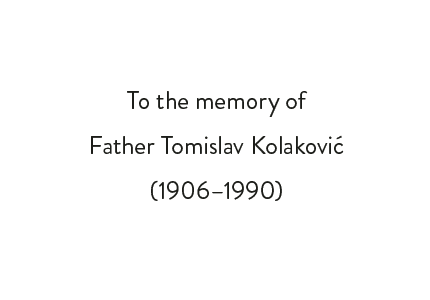Building An American Kolakovic Family

Here is the dedication page from my forthcoming book Live Not By Lies:

As regular readers know, Father Kolakovic was a heroic Croatian priest who escaped Zagreb in 1943, just ahead of the Gestapo, which was trying to arrest him for doing anti-Nazi resistance work there. He landed in Bratislava, the capital of the Slovak region of what was then Czechoslovakia. He ditched his Croatian last name (Poglajen) and lived undercover using his mother’s maiden name, Kolakovic.
Father Kolakovic had studied the Soviet Union in the Russicum, the Vatican college that trained priests in Russian and Soviet studies. He knew how the Soviets thought. When he arrived in Bratislava and took up a teaching position in a university there, the priest told his students that the Germans were going to lose the war, but when the war was over, the Soviets were going to impose communism on their nation. When that happened, he said, the communist state was going to attempt to crush the Church, most of all by going after the clergy. The best hope the Slovak Christians had to survive what was coming was to build a strong, well-formed lay resistance movement, one that was capable of acting in the face of the institutional Catholic Church’s coming captivity.
Father Kolakovic organized what he called “the Family” — a network of small groups of Catholic students, who would gather for Sunday mass, prayer, and discussion. Their discussions weren’t only spiritual. They talked about the political and social situation in their country, and what living as faithful Christians there required them to do.
The Family spread all over the Slovak region. The Catholic hierarchy was generally skeptical of it. They thought Father Kolakovic was being alarmist, and in their clericalism, tendered suspicion over how much he was focusing on empowering the laity. Father Kolakovic was no revolutionary within the Church’s ranks. It was only that he understood what the Slovak bishops were slow to grasp: that the communists in power were going to be ruthless with the clergy, and attempt to exterminate the faith of the Slovak people by clamping down on the bishops and priests.
Germany lost the war in 1945, of course. In 1946, Czechoslovak authorities expelled Father Kolakovic. In 1948, there was a communist putsch, and everything Father Kolakovic predicted came to pass. But the Family was ready. When the state promulgated a law forbidding priests from working, the lay members of the Family, and allied priests, began to build the structure of the underground church. Most of them were in prison by 1951, but they persisted, and when they were released in the 1960s, resumed their labors. Jan Chryzostom Korec had been secretly ordained as an underground bishop, and helped direct and support their labors.
From Live Not By Lies:
František Mikloško, now in his seventies, was a central leader of the second wave of the Slovak underground church. When we meet for lunch in a Bratislava restaurant, he is quick to offer advice to the current generation of Christians, who, in his view, are facing a very different kind of challenge than he did at their age.
“When I talk to young people today, I tell them that they have it harder than we did in one way: it is harder to tell who is the enemy. I tell them that what is crucial is to stay true to yourself, true to your conscience, and also to be in community with other like-minded people who share the faith. We were saved by small communities.”
Mikloško, in his youth a close aide to the underground Catholic bishop Ján Chryzostom Korec, credits the clandestine bishop—made a cardinal by Pope John Paul II after communism’s fall—with emphasizing the importance of small communities.
“He told us that they”—the communists—“could take everything from us. They could take samizdat from us. They can take our opportunity to speak out publicly from us. But we can’t let them take away our small communities.”
Mikloško started university in Bratislava in 1966, and met the recently released prisoners Krčméry and Jukl. He was in the first small community the two Kolaković disciples founded at the university.
Christians like Krčméry and Jukl brought not only their expertise in Christian resistance to a new generation but also the testimony of their character. They were like electromagnets with a powerful draw to young idealists.
“It’s like in the Bible, the parable of ten righteous people,” says Mikloško. “True, in Slovakia, there were many more than ten righteous people. But ten would have been enough. You can build a whole country on ten righteous people who are like pillars, like monuments.”
These early converts spread the word about the community to other towns in Slovakia, just as the Kolaković generation had done. Soon there were hundreds of young believers, sustained by prayer meetings, samizdat, and one another’s fellowship.
“Finally, in 1988, the secret police called me in and said, ‘Mr. Mikloško, this is it. If you all don’t stop what you’re doing, you will force us to act,’” he says. “But by then, there were so many people, and the network was so large, that they couldn’t stop it.
That year, the underground church called the Candle Demonstration, the largest mass protest in Czechoslovakia since the 1968 Soviet invasion. It was a powerful precursor to 1989’s Velvet Revolution, which cast out communism.

Jan Simulcik, a contemporary Slovak historian, was a college student in the 1980s, and an activist in the underground church. He and his cell of fellow young Catholic men were part of the group that distributed Christian samizdat. They knew that if they were discovered, they would instantly go to prison. They acted as they did because they were men of faith, but also because they were inspired by the older men who led them in fact and by example:
“Most of us had fear, but there were people among us who really did act absolutely fearlessly. I’m thinking about Silvo Krčméry, Vlado Jukl, Bishop Korec, but there were hundreds, even thousands of others,” says historian Ján Šimulčik. “Young people like me saw their example and were able to grow in courage by their example. The lesson here is that when you see someone acting courageously, you will act courageously as well.”
What would the history of the church in Slovakia have been if not for Father Kolakovic, Father Jukl, Bishop Korec, Dr. Krcmery, and their disciples? It is impossible to say for sure, but know this: the Family was critically important to the church’s survival.
What about us? What will history say of us? What will our children and grandchildren judge? Look: it’s 1943 in America today. The main message of my book is that we faithful Christians have to prepare for a time of great trouble, even persecution. The book offers concrete suggestions from men and women who lived through the hard totalitarianism of the Soviet era. What I hope readers of Live Not By Lies will do is come together, wherever they are, to start small resistance cells modeled after Father Kolakovic’s family. He did it in a specifically Catholic context. Christians in America, in 2020, have to adapt the method to their own ecclesial context. I am putting together now a study guide and reading list to accompany Live Not By Lies, to help seed the creation of these cells nationwide. This will be made available for free when the book is published on September 29.
This morning I was in touch with the publisher, Sentinel, about this project. If you are a teacher or a religious leader who is drawn to the ideas in the book, and who thinks I might be on to something with the Kolakovic idea, then Sentinel is offering to send a digital advance reader copy of Live Not By Lies to you. I don’t know what limitations there might be on this offer, but if you would like to be considered, please e-mail me at rod — at — amconmag — dot — com, with LIVE NOT BY LIES in the subject line, in all caps, and I will forward your request to the folks in the New York office. Please identify the school in which you teach or the church group that you lead. This is only so we can keep up with the kind of people who are interested in the book.
To be clear, this is not a Catholic book, a Protestant book, or an Orthodox book. There are believers and confessors from all three Christian traditions interviewed in the book. Though it focuses on Christians, the strategies in this book will be applicable in most cases to believing Jews and Muslims too. We are all in this together. One thing I learned from reading the testimonies of survivors of the gulag was that religious differences melted away under persecution. Protestants, Catholics, Orthodox, Jews — in communist prisons, and under torture, they were just brothers and sons of the living God.
One last passage, including a quote by the saintly Lutheran pastor Richard Wurmbrand, tortured in Romanian prisons for his faith:
The faith that martyrs and confessors like the Christians cited here is a far cry from the therapeutic religion of the middle-class suburbs, the sermonizing of politicized congregations of the Left and the Right, and the health-and-wealth message of “prosperity gospel” churches. These and other feeble forms of the faith will be quickly burned away in the face of the slightest persecution. Pastor Wurmbrand once wrote that there were two kinds of Christians: “those who sincerely believe in God and those who, just as sincerely, believe that they believe. You can tell them apart by their actions in decisive moments.”
The kind of Christians we will be in the time of testing depends on the kind of Christians we are today. And we cannot become the kind of Christians we need to be in preparation for persecution if we don’t know stories like this, and take them into our hearts.
The ultimate goal of Live Not By Lies is to prepare souls to act courageously and rightly in the decisive moments to come. If you think that your students, or your religious group (especially young people), need to hear this message and act on it, then e-mail me, and I’ll put you in touch with Sentinel. Again, you will be sent an unsharable digital copy of the book for preview. If you think its message is worthwhile, I would appreciate you telling others. The publication date is September 29 — in the Western church, the Feast of St. Michael The Archangel. Which was not planned, but is appropriate.
